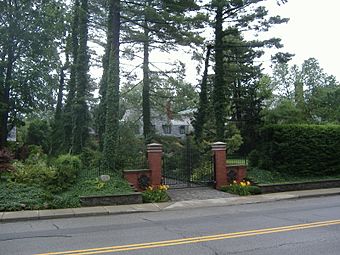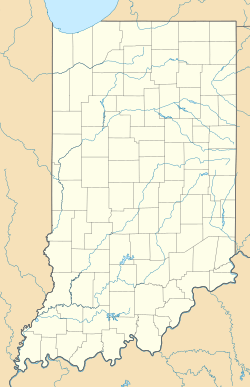Washington Park Historic District (Indianapolis, Indiana) facts for kids
Quick facts for kids |
|
|
Washington Park Historic District
|
|

Faux Château de Malmaison within the district
|
|
| Location | Bounded by Pennsylvania Street and Central Avenue between 40th and 43rd Streets in Indianapolis, Indiana |
|---|---|
| Area | 60 acres (24 ha) |
| Architect | Hunter, Frank; et al. |
| Architectural style | Late 19th And 20th Century Revivals, Bungalow/craftsman |
| NRHP reference No. | 08000565 |
| Added to NRHP | June 24, 2008 |
The Washington Park Historic District is a special area in Indianapolis, Indiana, known for its old and beautiful buildings. It was added to the National Register of Historic Places on June 24, 2008. This means it's recognized as an important place in history.
The district covers about 60 acres, which is like 45 football fields! It's located about 4 miles north of downtown Indianapolis. You can find it in the Meridian-Kessler neighborhood. The district includes properties between 40th and 43rd Streets, and between Central Avenue and an alley near Meridian Street. Washington Boulevard runs right through the middle.
Contents
A Look at Washington Park's History
Washington Park became part of the city of Indianapolis in 1906. For a while, the streets were not paved. They finally got paved in November 1916. Even then, 43rd Street didn't have sidewalks or pavement until 1923.
Growing Popularity
In the 1920s and 1930s, new apartment buildings were built in the district. These apartments attracted young professionals. People liked the neighborhood because it was seen as a very "prestigious" or fancy place to live.
Buildings and Architecture
The Washington Park Historic District has many different kinds of buildings. Most of them were built before World War II. There's a church, which is the Holy Trinity Hellenic Greek Orthodox Church. You'll also find two-family homes called duplexes, and a building with four apartments. There are also many single-family houses.
Architectural Styles
Many of the buildings show off different architectural styles. These styles are often inspired by older European designs. You can see buildings in the:
- Classical Revival style
- Colonial Revival style
- Italian Renaissance style
- Tudor Revival style
These styles make the district look very unique and interesting.
Famous Homes in the District
Two homes in the Washington Park Historic District are especially notable.
The Harry Hartley House
One very special house belonged to Harry Hartley. His home was designed to look like a smaller version of the Château de Malmaison in France. This French castle was once a residence of Napoleon Bonaparte, a famous French leader. Harry Hartley even sent his architect, William Earl Russ, to France to study the original castle!
Albert J. Beveridge's Home
Another important building is the home of Albert J. Beveridge. He was a United States Senator. While living in this house, he wrote a biography about John Marshall. John Marshall was a very important judge, the Chief Justice of the United States Supreme Court. Beveridge's book won a special award called a Pulitzer Prize.




